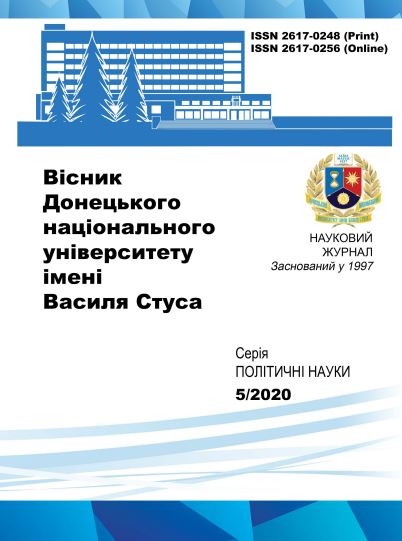Ethnic separatism, its place and role in political processes
DOI:
https://doi.org/10.31558/2617-0248.2020.5.9Keywords:
separatism; globalization; national liberation movement; secession; ethno-territorial conflictAbstract
One of the most actualized ethnopolitical problems of our time is the growth in the number of separatist movements in different parts of the world. This phenomenon developed and gained strength in the second half of the 20th century simultaneously with the anti-colonial and national liberation movements. Moreover, it is worth noting that movements that set as their main goal the separation of a certain part of a multinational state and the creation of an independent national-state entity in this territory, have intensified not only in third world countries, where the colonial legacy left a significant number of disputed borders, but and in the oldest Western democracies. The course of the processes of ethnic separatism in multi-ethnic states largely depends on the degree of development of democratic institutions and values in society. Depending on this factor, the movement for secession from a single state may take the form of a constitutional process and public dialogue, or an intra-state conflict (or even war, depending on the scale of the violence). Briefly summarizing the above, it is necessary to highlight the following. Ethnic separatism means a movement whose main goal is to secede an ethnic region from a multinational state and create its own state formation or join another state. Thus, the concept of ethnic separatism does not include such phenomena as the disintegration of the state or its regionalization (so-called economic separatism), which act as independent processes not directly interdependent on the phenomenon of ethnic separatism. Ethnic separatism, as a phenomenon, to one degree or another inherent in all multinational states, has a serious impact not only on intrastate group relations, but also on international politics, which makes it possible to characterize it as a challenge to the world order that emerged after the end of the Cold War.
References
Bates R. Ethnic Competition and Modernization in Contemporary Africa Comparative Political Studies. 1974. – Vol.6. #4. – P. 156-189.
Brown C, Boswell T. Ethnic conflict and political violence: A cross-national analysis // Journal of political and military sociology. 1997. – Vol. 25. – # 1. – P. 111-130.
Brown D. The State and Ethnic Politics in South-East Asia. London, 1994.
Brubaker R. Nationalism reframed: Nationhood and the national question in the New Europe. – Cambridge, 1996. – 202 p.
Bugajski J. Ethnic Politics in Eastern Europe. – Armonk, New York, 1994. – 493 p.
Burbach R, Nunez O, Kagarlitsky O. Globalization and its Discontents, The Rise of Postmodern Socialisms. – London, 1997. – 196 p.
Carment D., James P. Internal Constraints and Interstate Ethnic Conflict // Journal of Conflict Resolution. March 1995. – Vol.39. # 1. – P. 82-109.
Cvetkovich A, Kellner D. Introduction: Thinking Global and Local / Cvetkovich A., Kellner D., eds. Articulating the Global and the Local Globalization and Cultural Studies. – Boulder, 1997. – 258 p.
Hale H.E. Statehood at Stake: Democratization, Secession and the Collapse of the USSR. Cambridge, 1998. – 243 p.
Hobsbawm E. The nation and globalization // Constellations. 1998. – Vol. 5. # l. – P. 1-9
Horowitz D. Ethnic Groups in Conflict. Berkeley, 1985. – 697 p.
Kellas J. The Politics of Nationalism and Ethnicity. New York, 1991. P. 39-49.
Laitin D.D. Identity in Formation: the Russian-speaking populations in the near abroad. – Ithaca, 1998. – 417 p.
Meernik J. United States Military Intervention and the Promotion of Democracy. Journal of Peace Research. 1996. – Vol. 33. # 4. – P. 391-402.
Henkin S. Separatizm v Rossii – pozadi ili vperedi? // Pro et Contra. 1997. T. 2. № 1. S. 27-43.

